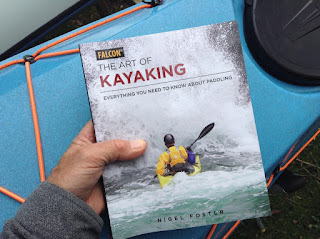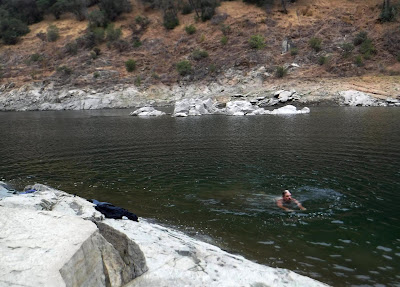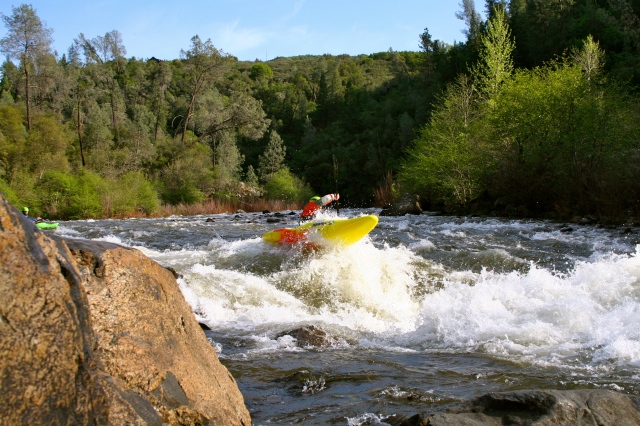Many a time I have merely closed my eyes at the end of yet another trouble some day and soaked my bruised psyche in wild water, rivers remembered and rivers imagined. Rivers course through my dreams, rivers cold and fast, rivers well known and rivers nameless, rivers that seem like ribbons of blue water twisting through wide valleys, narrow rivers folded in layers of darkening shadows, rivers that have eroded down deep into the mountain's belly, sculpted the land, peeled back the planet's history exposing the texture of time itself. --- Harry Middleton
Loading up at other places that people find easier to get to. I sometimes get into conversations with boaters about where they like to paddle around Sacramento.
"Have you ever been up to Rattlesnake Bar?" I'll ask them.
The answer is usually either bewilderment or not for a long time as they think of the last time they were up there.
Rattlesnake Bar is part of the California State Parks Folsom Lake Recreation Area. Located on the on the north arm of the lake, it's down a long dead-end road after the fork winding past white fences and horse barns towards the entrance of the park.
The lake glistens, flashing through the oaks and willows while driving down the narrow road after entering the park. During the drought years not too far back, it looked more like Mars seeing the dusty remnants of the lake. But, this year the lake is brimming. The lake is 50 feet higher than last year. Going into the last week of September, many recreation lakes in California have the highest lake levels for this date in more than 10 years.
Forget weekends. Come to Rattlesnake Bar mid-week in the summer or wait till late fall or early spring to escape the speed boat and jet ski crowd. This is a playground for them all summer long when the lake is full and gate to the ramp is open.
The water was still touching the end of the ramp on my last visit. In previous trips, I can remember some lengthy treks while shouldering my kayak down the ramp or along an arduous trail down a steep bank to the lake. The guidebooks said to watch for rattlesnakes, hence the name, but, it should've of warned me about that thick layer of muck and slimy goo in front of the lake.
The water was a silty brown turned up by waves of jet skis and speed boats. It resembles more a choppy over perked coffee and cream color even past the 5 mph buoy about a mile north of the access. Those with a need for speed turn around and head back to the main part of the lake while those in search of the quiet of the lake, canyon and river, proceed on.
Past Mormon Ravine the lake widens and turns to the northeast. On the north side, the old Pony Express Trail is now a hiking path along the lake. Further up the lake narrows with rugged rocky ledges on both sides. I don't feel the tug of current on this visit, but I have before. It's common through here, for the lake to behave more like a river as the water level dictates where the river ends and the lake begins. There is a sudden change of water temperature and clarity as the cool mountain North Fork of the American River pours into the lake. It was now a refreshing cold and running transparently clear.
"I have never seen a river that I could not love," wrote Canadian writer and conservationist Roderick Haig-Brown, "Moving water...has a fascinating vitality. It has power and grace and associations. It has a thousand colors and a thousand shapes, yet it follows laws so definite that the tiniest streamlet is an exact replica of a great river."
When I started kayaking, I dreamed of these river places Haig-Brown called "Water in its loveliest form." A clear water passageway between massive ramparts of broken disheveled texture, as the once molten rock now crystallized over millions of years, is exposed, lifted and shattered along the fault lines while large boulders have become their own islands raising from the depths.
The stream, flecked with little white waves and quiet inviting pools, while just around the bend there is the sound of the thundering water echoing off the chasm walls and the sight of a churning cascade, what naturalist John Craighead called, "A primeval summons to primordial values."
I have paddle upstream here before, even portaged through shallow rapids to the river's slow moving pools. On this trip, however, the lake covers those rapids and the low water landmarks I'm familiar with going to north past Pilot Creek. At Oregon Bar Rapids, there is no need to go any further on this outing, as the rushing water turns me back downstream.
Above Pilot Creek I found a nice flat rock and water warmed by the sun. I beached my kayak and surveyed my river surroundings. Upriver, I could see the foam of whitewater while down downstream the rugged curve of the canyon suffused amber light of the late afternoon sun. I spent a good chunk of time there becoming a kid again. Diving off rocks, swimming between dives and exploring the view of the canyon.
Light and shadows dance across the water as the sun slips behind the horizon on my paddle back to Rattlesnake Bar. The hills and trees obscurity is offset by the warm glow of the water. My senses are awakened by the stillness and coolness of the air as I glided silently and almost effortlessly across the placid lake of golden glass.
"We do not want merely to see beauty, " said writer
C.S. Lewis, "We want something else which can hardly be put into words to be united with the beauty we see, to pass into it, to receive it into ourselves, to bathe in it, to become part of it."
And with each stroke of my paddle, I soaked in all the lake's and river's tranquil magic.
Lake Clementine Update
To make the extension to the boat ramp at Auburn State Recreation Area’s Lower Lake Clementine the ramp is be closed to vehicles and vessel launching until the lake refills to its normal level, which is estimated to happen by late October or early November. The
Auburn Journal reported the extension will add about 10 feet of length to the boat ramp and is estimated to cost about $85,000 when complete. Breaking down the closure, it was estimated to8 to 12 days to lower the lake while the actual boat ramp extension project lasted five days. Then it will be another three to four weeks before the lake has refilled and launches allowed again.
The area will remain open to bicycle and foot traffic during the project.
Upper Lake Clementine will remain open on Fridays, Saturdays, Sundays and Mondays through the end of the month. From Oct. 1 to 15, the upper lake will be open Saturdays and Sundays only. After Oct. 15, Upper Lake Clementine will be closed for the season.











































